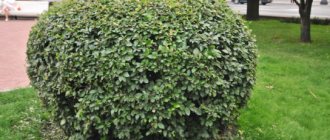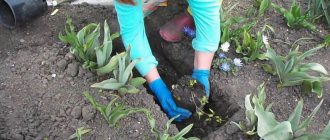Moscow and the Moscow region are a region where it is cold for at least 5 months a year. Already in November, snow may fall, and spring does not always come with the onset of March. Frosts are possible down to -25-30ºС and in summer the heat reaches +35ºС. Moreover, unlike Siberia, the snow cover is not constant, and temperature fluctuations are very sharp and noticeable.
We should also not forget about the heavy traffic load, which affects the cleanliness of the air. Gas pollution, frequent temperature changes, dry periods - all these factors must be taken into account when choosing shrubs for garden plots.
Important! To prevent the area from looking like a chaotic multi-colored spot, consider in advance what to plant where, so that during flowering it looks harmonious, and not tacky and tasteless!
Buddleya
The bright, exotic buddleia arouses interest and admiration among everyone who looks at photos of shrubs for their garden. The plant looks great in the garden, has a pleasant aroma and attracts numerous butterflies. Buddleia Davida often reaches a height of 2.5-3 m. The bushes bloom long and profusely.
When planting buddleia, there are several points to consider:
- the plant needs fertile soil;
- planting should be done in a sunny place;
- the ideal time for rooting seedlings is the off-season;
- In winter, bushes require shelter from frost.
Dry branches and dead parts must be removed regularly. Pruning is carried out once a year - this affects the intensity of flowering.
Low-growing shrubs for the border
Perennial decorative deciduous shrubs suitable for creating border hedges include:
- low-growing barberry;
- rhododendron;
- boxwood;
- cotoneaster;
- honeysuckle;
- caragan;
- Fortune's euonymus.
The choice of unpretentious plants includes gorse, cinquefoil, mahonia, almonds, currants and gooseberries, snowberry, spirea, and chaenomeles.
Annual individuals will live a short but vibrant life. The crops are inexpensive and bloom beautifully. Annual renewal of the edging allows you to create fresh compositions of beautiful plants. Below is a small list of the best varieties:
- marigolds with double and simple flowers;
- sun-loving nasturtium;
- drought-resistant verbena;
- ageratum with an amazing blue color;
- ground cover Iberis;
- silvery cineraria;
- lush argyrantemum (proper cultivation and care at home allows the annual to reach the size of a shrub).
Decorative border of low-growing bushes
The overall impression of the work of art depends on how well the frame matches the picture. Border flowers create a kind of frame that borders flower beds, paths, and beds in geometric gardens. However, natural style gardens do not use borders at all. Bricks, tapes or fences can be used as fencing. It's a matter of taste. Using fresh flowers where appropriate is always impressive.
Hibiscus
A beautiful shrub that is very popular among summer residents. The decorative qualities and unpretentiousness of the plant allow it to be used in any space. Capable of reaching 2 m in height. It has dense shoots and very beautiful flowers of an original shape with wavy edges.
To plant hibiscus, choose the most illuminated area. Before the onset of frost, the base of the bush is covered to protect it from low temperatures.
Hibiscus needs regular, fairly frequent watering. It is unacceptable for the soil to dry out, especially in the heat. To support the plant during flowering, complex fertilizers are used.
Aronia chokeberry
This berry bush is considered a plant with healing properties. Summer residents are also known as chokeberry. Attracts gardeners with the red-yellow coloring of the leaves. It begins to bloom at the very end of spring - after all the foliage has bloomed.
By the end of the flowering period (after 2 weeks), the fruits begin to ripen: black or red berries with a slight whitish coating. You can start picking berries in October - it’s better to wait for frost. Aronia fruits have a tart, sour-sweet taste.
The plant reproduces in several ways. Gardeners use:
- dividing the bush;
- layering;
- vaccinations;
- basal shoots.
Planting is usually carried out in the spring. Chokeberry is not too demanding on care and soil. It grows well in both light shade and full sun. High groundwater levels will not be a problem either.
Hawthorn
Another perennial shrub for the garden, which is planted with pleasure to decorate the landscape. The decorative qualities of hawthorn allow it to also be used as a hedge.
Both flowers and fruits of hawthorn have medicinal properties: they are used in complex therapy of cardiovascular diseases. They contain flavonoids, carotenoids, beneficial acids and other valuable substances.
The bush withstands strong winds, so birds love to build nests in its branches. Attracting birds to protect the garden from pests is an added plus. In autumn, hawthorn leaves acquire a very bright color, and in spring and summer, white, pink or red inflorescences develop on the bushes.
Tips and recommendations for decorating a garden plot using ornamental shrubs
To ensure that your garden plot always looks attractive and the plants are pleasing to the eye, you should follow some rules:
- Decorative perennials are most often unpretentious in care and require only systematic and regular pruning and adjustment of shape. Old branches are removed to activate and grow fresh shoots, and the formation of the crown directly affects the appearance of the bushes.
- To create a hedge, it is recommended to prune plants starting from the moment of planting.
- Dwarf varieties are usually designed so that they are lush and squat.
- Bright and showy shrubs should be highlighted against the background of green or evergreen representatives.
- Green bushes often serve as a background, so they should prevail.
- Plants with rare colors should serve as the highlight of the composition. They should be complemented with white or silver shades.
- Plants with variegated foliage need a lot of light, and if there is not enough light, they can fade.
- It is important to select shrubs so that during flowering they merge into a single harmonious picture.
- Ornamental shrubs are planted both individually and in groups. They look spectacular on spacious lawns in front of the house, along paths, a fountain or a pond.
Ornamental shrubs are widely used when creating site design.
Hydrangea paniculata
Blooming hydrangea leaves no one indifferent. Pink, blue or white inflorescences bloom around mid-summer. Frost resistance also adds to the popularity of the plant: unlike most shrubs, it tolerates winter well.
An adult bush can reach 2 m in height. The inflorescences are large, 25-30 cm long and 15 cm in diameter. Blooms from mid-July to late October. The ideal place for planting is shaded at midday. Hydrangea does not do well under the summer sun at the peak of the heat.
The shrub is moisture-loving; it needs to be watered abundantly, at least twice a week. Water for irrigation should be used soft, without chlorine, ideally rainwater.
When watering, it is necessary to avoid getting water on flowers and leaves - this reduces the decorative qualities of the plant. Fertilizing hydrangea with aluminum sulfate at the rate of 30 g per bucket of water allows you to change the color of the inflorescences: pink flowers become purple, and white flowers become blue.
Decorative blooming
Forsythia europaea
On this shrub, in early spring, flowers of a bright sunny color first appear, and only after they fall off do the leaves grow. The time of his yellow “dominance” is March, April. It grows up to 2 m in height and 3 m in diameter, and has the shape of a hemisphere.
Advantages: early color, does well in partial shade, relatively drought tolerant. It can live up to 70 years, blooms early and abundantly, flowers along the entire length of the branches - from the bottom to the top.
Where to plant: alone on the lawn or surrounded by early flowering bulbs, also combined with other bushes and suitable for use as a hedge. Light soils are suitable; it is better to choose a sunny site without cold winds. Does not tolerate high humidity well.
Care: it tolerates wintering better if you mulch and bend the branches to the ground so that they overwinter under snow cover. In the spring, it is necessary to remove the old mulch, apply mineral fertilizers and add a layer of manure or humus. Then trim off the tops and dry stems.
Almond triloba – Louiseania triloba
Louiseania delights the eye twice a year - in May, when pink buds bloom and bloom, and in autumn, when the foliage takes on a bright fiery hue. For almost 3 weeks, branches strewn with double flowers similar to sakura decorate suburban areas.
It usually grows up to 2-3 m. It tolerates frost and may be defenseless against sudden temperature changes in early spring if the shoots wake up ahead of time.
Advantages: delicate flowers, similar to sakura, also attract attention in the fall with the orange-red hue of the foliage, are frost-resistant, cut branches are suitable for making bouquets and stand in water without falling off for up to 1.5 weeks. Can be grown in urban environments.
Where to plant: in a group of shrubs, next to perennial flowering plants, spirea or daylilies. Shadow and excess moisture are the enemies of Louiseania; it is better for it to choose a place in a sunny, windless space.
Care: cover for the winter so that the ends of the shoots and buds do not freeze and the root collar does not rot. Watering is needed in moderation; it should be watered abundantly only during flowering. Be sure to trim thick branches to maintain shape and to avoid thickening, after the flowers fall, the branches are cut by 2/3.
Chaenomeles - Japanese quince
An exotic fruit and berry shrub with thorns and 3-5 cm flowers. White, pink or red-orange. Blooms profusely for up to 20 days in May-June. By October, orange or yellow-green fruits weighing about 45 grams ripen on the bush, resembling an apple or pear in shape (depending on the variety). From each bush, 2 kg is collected. Henomelis begins to bear fruit at 3-4 years. They are not consumed fresh, but they make excellent jams, preserves, and marshmallows.
Advantages: unpretentious to soils, even damp clay or sandy ones are suitable, excellent honey plant, strengthens loose soil to prevent erosion. The vitamin C content in fruits is higher than that of lemon! They also contain many vitamins, microelements, carotene and pectins.
Where to plant: in single plantings, as a hedge or border, also looks great in alpine hills and rockeries, the Rubra variety is used as a bonsai. If you want to get a fruit harvest, you should choose lighted places and plant several seedlings for successful cross-pollination.
Care: shoots older than 5 years are removed, no more than 20 branches are left to prevent thickening, in the spring it is necessary to feed with nitrogen fertilizers, after the fruits have formed, complex solutions of potassium and phosphorus are also added, by winter it is important to protect from the wind by covering with spruce branches or installing a snow-retaining shield.
Common lilac
A bush with many trunks, sometimes growing up to 8 m. There are about 30 species and 500 varieties! The rich palette of shades and fragrant aroma have attracted fans for many years, remaining a favorite despite new items and exotics. Flowers appear in the 3rd year and bloom by the end of May, beginning of June. Tolerates drought and frost well.
In addition to beauty, flowers, buds and leaves can be used to treat many ailments - as an antipyretic, anti-inflammatory, diaphoretic, diuretic, anticonvulsant, analgesic. It is used as tea, tinctures, ointments, compresses and lotions are made.
Advantages: does not require complex care, tolerates frost and heat, has useful medicinal properties, has a wide variety of shapes and shades
Where to plant: tall and spreading bushes grow best separately, bloom even in partial shade, but then there are fewer flowers, can grow on mountain slopes and any soil except swampy and clayey.
Care: it is important to trim the inflorescences after flowering so that by next year the bush will be more luxuriant, watering is not required from mid-July, otherwise the buds may awaken, for the first 3 years you can do without fertilizing, provided that fertilizers were added to the hole before planting, for the winter you can do not cover.
Spiraea Van–Gutta
A fast-growing crop from the Rosaceae family, which does not grow higher than 2 m. A lush, spreading crown with hanging branches, on which cap-shaped white inflorescences bloom by June or even early July (if the spring turns out to be cool). Under favorable conditions it blooms twice a year. In autumn, the foliage turns purple and decorative fruits appear. It blooms after 2 years.
Advantages: grows on dry sandy soil, thrives in the shade, tolerates air pollution (ideal for urban and suburban conditions), does not require frequent watering, tolerates low temperatures, excellent honey plant.
Where to plant: universal - a bright representative of solitaire plants, and at the same time suitable for use in hedges, borders, near ponds; cut inflorescences are used to make bouquets and compositions; it can grow even in wet soils.
Care: faded inflorescences are pruned after flowering and to give shape, covered with foliage and peat for the winter; when frozen, dead shoots are cut off and quickly restored.
Deytsia rough or star-shaped
A plant brought from China and Japan, with rough leaves with small hairs. Flowers of pink, crimson, lilac, white or carmine appear in July-August, and the fruits ripen in October.
Advantages: disease resistant, lush flowering, goes well with coniferous trees and bushes, versatility of use.
Where to plant: can grow either alone or in combination with lilac, hydrangea, weigela, mulberry, chaenomeles and other shrubs and flowers, used in hedges, borders and landscape compositions. Demanding on soil - you need light, rich in minerals and organic matter soil.
Care: mulching is not necessary, watering 1-3 times a month, pruning - thinning and after flowering, for the winter it is necessary to cover with spruce branches or non-woven material, bending the branches to the ground.
Barberry Thunberg
Brought from the Far East and valued for its variety of foliage colors, shapes and protective properties, thanks to its long spines. An unpretentious but very impressive plant with yellow to reddish-purple foliage and small oval decorative fruits. It blooms in May, 5-6 years after planting, with inflorescences collected in bunches or short brushes. The decorative value is fully manifested in the fall, when the foliage begins to play with the seven colors of autumn.
Advantages: no need to prune at all, very effective throughout the warm season, does not require watering or heavy fertilizing, resistant to diseases and severe frosts
Where to plant: in Japanese gardens, near ponds, to create borders, hedges, in landscape compositions and also in single plantings. They can grow in partial shade, but then the color of the foliage changes.
Care: pruning is required if the ends have frozen over the winter or you want to give the hedge a certain shape, it is useful to loosen, mulch and apply organic fertilizers; this variety does not need to be covered for the winter.
Common mock orange
People call this bush jasmine. Large white flowers appear in late spring and early summer and delight with their appearance and fragrance for almost a month. Its delicate aroma and low maintenance make it a favorite among garden and park crops.
Advantages: tolerates cold well, can grow near groundwater and in the shade, does not suffer from smoke and exhaust gases.
Where to plant: in a single planting and in a composition of other shrubs. It loves the sun, but will also bloom in the shade, while the bush will stretch upward and the flowers will become larger.
You may be interested in: Layout of a dacha plot: how to properly zone, diagrams with photos Do-it-yourself dacha gates: varieties and design features How to design a fire pit in a dacha with your own hands: step-by-step instructions
Care: pruning is required after flowering so that new shoots form by autumn, minimal watering - after planting and during the period when the flowers gain strength. It does not require shelter for the winter and easily tolerates temperatures down to -30ºС.
Cinquefoil shrub – (Quintuple leaf) – Kuril tea
A low bush up to 1 m high and up to 1.2 m wide with very abundant and long flowering - from June to October. An amazing feature is that yellow flowers and leaves are used as tea, which helps with colds and also normalizes metabolism and calms stress. The tincture is used for burns and wounds.
Advantages: it blooms for 3-4 months, in addition to its beauty, it is very useful and eaten, can be planted in any combination.
Where to plant: on fertile soils, but takes root on clay, rocky and slightly alkaline soils; it feels more confident in partial shade. A universal look that can be combined with almost everything - coniferous and deciduous trees, tall shrubs, in compositions and rose gardens, to create borders and hedges.
Care: does not require shelter for the winter, moderate watering, tolerates pruning well for shaping and rejuvenation in the fall after flowering or in the spring before the formation of leaves.
Budleya variablea
“Moth Tree” or “Butterfly Magnet” is another name for this bush with a honey aroma and flowers that look a little like lilacs. The color is usually lilac, but also comes in crimson, burgundy, purple or white. Grows up to 2-3 m, sometimes even up to 5 m. Loves tropical humid climate.
Advantages: blooms for 6 weeks, starting in late summer, grows quickly.
Where to plant: good both in single and group plantings, it is better to combine with shorter species. Can be planted in large tubs to decorate terraces or patios so that they can be removed indoors for the winter.
Care: pruning is very important to give it shape and preserve it from frost. For the winter, it is better to cover the arches with a film on top, but be sure to leave an air gap so that the roots do not dry out. Fertilizing with nitrogen, phosphorus and potassium fertilizers is done in spring and summer.
Hydrangea
Airy, light, lush spherical inflorescences of the most bizarre shades - pink, lilac, lilac, blue, white, blue will decorate any area. Depending on the variety, it grows up to 3 or even 10 m. Petiolate hydrangea is used for weaving arbors and reaches 25 m. Flowering occurs in the spring and only falls off with the onset of frost. Hydrangea root is used to treat genitourinary diseases, reduce swelling and heal wounds.
Advantages: it blooms for more than 4 months, can be in the shade and grow in acidic soil, has medicinal properties, looks very beautiful in fresh and dried bouquets.
Where to plant: Ideal for flower beds and flower beds, in combination with hosta, ferns and other shade-tolerant shrubs on the north side.
Care: moisture-loving, does not tolerate drought well, pruning is needed during bud swelling and for wintering. It is better to cut off old bushes at the root before winter, and cut off the flowers on young shoots after they fall. Requires horizontal shelter in cold weather.
Rhododendron
Shrubs about 1 m high, rarely growing to 1.5-2 m. with large inflorescences of orange, red, pink or yellow. It blooms in late June-July and the color lasts about 3 weeks. Feels better in warm regions.
Advantages: grow well near bodies of water, strong immunity to diseases and pests, long-lived plant, can live up to 200 years.
Where to plant: in the shade of tall plants on sandy loamy acidic soils, near rivers, lakes, ponds. It is planted singly, in compositions, hedges, borders, alleys, and looks impressive when planted in masses of bushes of different colors.
Care: for the winter it requires covering with non-woven material on the frame, it is important to ensure that the soil is acidic, so when watering the water must be settled or acidified.
Common heather
An evergreen hardy plant that does not grow higher than 1 m and is more reminiscent of a tapestry during the flowering period. Cherry, purple, white, crimson and pink inflorescences appear in July and remain on the branches even when dried until October.
Advantages: able to grow in the most unfavorable conditions, excellent honey plant, used for making juice for throat diseases, tinctures, decoctions, tea, soothing baths.
Where to plant: will take root on peat, sandy, swampy soils, slopes, wastelands. Can be planted near stones, in rockeries, in open areas and in combination with other plants. They are also grown in pots on the balcony and terrace.
Care: avoid soils rich in calcium, prune in the spring before active growth and cut only along the green part of the trunk, without touching the wood. In winter, you can cover it with spruce branches and sprinkle peat around the shoots.
Park rose
“Cultivated rose hips” is another way to call numerous types of park roses. The most common are Canadian and English. It blooms by the end of May and delights for more than a month with its lush and bright buds from white to dark purple, including pink, yellow and orange. Some varieties bloom twice.
Advantages: resistance to drought, abundant and long flowering, high decorative value due to fruits that persist until frost.
Where to plant: arches, arbors, facades, hedges, background for flower beds, in combination with coniferous and climbing plants or in a single planting. In a sunny and ventilated place on loose enriched soils, ideally loam with humus and compost, diluted with sand.
Care: the one brought from Canada is more adapted to wintering and tolerates frosts down to -40ºС, the “English” one requires shelter for the winter. Watering is moderate, if there is no drought, it stops from the end of August.
Jasmine
Unlike mock orange, real jasmine in our latitudes is grown in pots and tubs. It is more of a vine that can grow from 2 to 10 m, depending on the species. The flowering period and the shade of the flowers also depend on the variety - white, yellow or pink. It has unique properties and is used for food, medicines and perfumery purposes.
Weigela
Twice a year - in spring and towards the end of summer, carmine-red, pink, cream and yellow buds bloom on this shrub. Brought from Japan and China, it has taken root well in our conditions. There are both dwarf ones with a spherical crown and those growing up to 3-5 m.
Advantages: repeat flowering, variety of varieties and shades, bud color changes from light to dark as they ripen, fruits form in the fall.
Where to plant: in nutritious, slightly acidic soils in sunny areas or in partial shade. Low-growing species are suitable for borders, flower beds, flower beds, and stone gardens. Tall ones will form an attractive hedge, decorate lawns when planted alone and in combination with barberry, roseberry, quince, cotoneaster and evergreens.
Care: it is important that the soil does not dry out; for this purpose, mulching and loosening are carried out. Pruning twice a year - after winter and between flowering. In winter, they are covered or wrapped in non-woven material, and spruce branches or litter are placed underneath.
Brugmansia
A lover of the tropics and subtropics with gramophone-shaped buds of white, yellow, orange and light green, which bloom in August-September and then again from October to November.
Important! The plant contains toxic substances and can cause headaches and hallucinations; be careful when planted in families with children.
Advantages: lush color in several passes, use for medicinal purposes, quite exotic and unusual appearance.
Where to plant: in our latitudes it is not suitable for open ground; it is grown on balconies, in tubs and pots and taken out to patios, terraces and gardens in the summer. Care: light-loving plant, for which a temperature of -5ºС poses a mortal danger. Loves ventilated places and light. You should monitor growth and transplant in time as it grows into a larger container.
Azalea
When thinking about what shrubs to plant in their dacha, many people choose azaleas. The plant tolerates both shading and bright sunlight. In this case, soil moisture must be maintained constantly. Luxurious shrubs delight with long-lasting abundant flowering.
The flowers come in a wide variety of colors: from orange and pink to white and red. For an azalea to develop well, it needs enough space - the shrub can reach 1.5 m in width. For planting, it is better to choose an area protected from the wind.
Azalea is not too demanding. It does not need trimming; it is enough to periodically remove drying inflorescences. The plant is suitable for gardens of any size, goes well with conifers, shrub trees, and looks great near artificial ponds.
The height of the bush and the shape of the crown may vary depending on the species. With age, the bush becomes denser. The soil must be fertilized with humus and peat: the soil must remain permeable. The soil at the roots is mulched with bark to prevent moisture evaporation - this saves the plant in hot, dry summers.
Features of growing plants
Before planting seedlings, it is better to clarify the timing of the appearance of flowers and place them so that they complement and replace each other. There are a wide variety of categories of shrubs that bloom at different times, so it is quite possible to choose them in such a way that there is always something pleasing to the eye on your site and does not bloom at once. To cut or not to cut? Most plants require pruning to give them shape, but some species are good in their original form, so that their carelessness gives a certain charm.











